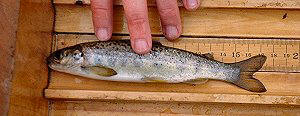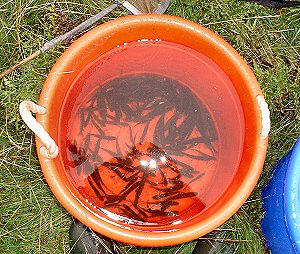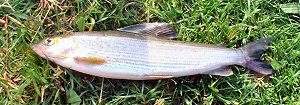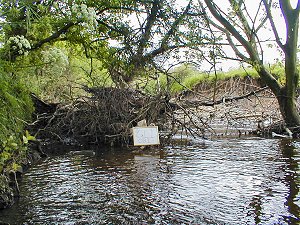Freshwater fish survey of the River Ayr shows mixed results
| Gathering Information | ||
| The River Ayr is the largest river in Ayrshire and has an extremely important and productive salmon fishery. Historically, the sea trout run in the river also provided excellent sport, although an alarming downward trend in catches over recent years has meant that nowadays they are rarely encountered. The river has suffered from a lack of detailed scientific information and it has been a priority for the Trust to begin addressing this. This summer, for the first time, the Ayrshire Rivers Trust has carried out a detailed scientific survey of freshwater fish in the River Ayr catchment. |  A healthy salmon parr from the River Ayr at Muirkirk. |
|
| Productive Upper Reaches | ||
| The results from this survey show that some areas of the river, particularly in the upper reaches of the Lugar and Ayr are extremely productive. These areas have the most pristine habitat, although in some cases, high numbers of salmonids were even found in sites situated immediately downstream of opencast coalmines.Habitat Degradation On the other hand, results from many of the smaller tributaries lower down the catchment, which historically are likely to have been particularly important for sea trout and brown trout spawning, showed evidence of serious problems. In many of these streams, salmonids were not present, or were found in extremely low numbers. In a few cases, no fish were found at all. In many of these sites, habitat was clearly degraded due to bank erosion and trampling by farm animals. Poor water quality, particularly due to enrichment, also appears to be an important factor. The results are currently being formally analysed and will be described in a detailed report next year. |
 A good catch of fry and parr from one of the burns in the upper Ayr catchment. |
Grayling study underway in the River Ayr
Introduction
The Trust has recently begun investigating the grayling population in the River Ayr with a view to assessing the current size and distribution of the population, and investigating the movement patterns and basic ecology of the fish in our rivers. Grayling have been caught by using electrofishing and seine netting methods at sites throughout the river catchment. The Trust staff hopes to continue sampling grayling throughout the winter, whenever water conditions are suitable.
Ecological Information and Tagging
All grayling have been returned unharmed to the water, after information on diet, length, weight and age have been collected. Small tags have also been put into most of the fish. These yellow tags are about the size of a grain of rice and have an individual code on them. Tagged fish can also be recognised by an adipose fin clip. We would be grateful if anyone who fishes for grayling could be on the lookout for these fin-clipped fish and report the tag number together with the time and place of capture to the Trust biologist at the address below. If a clipped fish is found with no tag, please also report this, as this indicates a missing tag and will allow us to calculate the percentage of lost tags in the sample. If anyone would be willing to help with the project further, please contact the biologist who would be happy to give you a free grayling angling logbook and measuring sticker to enable you to keep an accurate record of your catch this winter.
Grayling Angling Day
As part of the project, the Trust also organised a grayling angling day with the Grayling Society on Sunday the 1st of November. Although river conditions were far from perfect, we were lucky to get a break in the weather and the day was a big success, with 11 grayling caught in total. Detailed information was obtained from some of these fish, which were returned to the river unharmed. Thanks to all of the clubs and proprietors on the river who allowed access, and helped with guiding on the day, and to the Mauchline and Ballochmyle club members who kindly provided breakfast at their clubhouse.
 |
A River Ayr grayling. The yellow tag behind the eye is visible. Note the adipose fin, which will be removed in all tagged fish. Please report the time and place of capture of any tagged or finclipped fish and note the tag number. This project was supported by grants from the Grayling Research Trust and the Scottish Executive. |
Wild Salmon in the Classroom!
With the help of Dailly Angling Club members and staff at the Girvan DSFB hatchery, the Trust ran this exciting education project for the first time earlier this year. The project, which is a modification of a scheme first devised by the Galloway Fisheries Trust, aims to teach children about the importance of a healthy river, and the life cycle and ecology of Atlantic salmon, by involving them in caring for their local streams and salmon populations.
Lessons
The project began by teaching the primary 6 and 7 class in Dailly Primary School about the life cycle of the salmon, and the various needs and threats facing salmon throughout their life. They also learnt about their local river and the effects of different landuse issues in the catchment.
Mini Hatcheries
The Trust then donated a specially designed mini hatchery and 100 salmon eggs to the class and showed the children how to care for the eggs, to ensure that the water remains clean and cold enough for proper egg development. The children then took responsibility for the eggs and once the eggs hatched in April, Ayrshire Rivers Trust staff took the children to a local stream where they release the young salmon into the wild. The project ended with a follow up visit in June, when the biologists demonstrated electrofishing methods and showed the children how much “their” salmon had grown since the spring. The project was a useful pilot scheme, and has taught us a lot about the practicalities of running these types of projects. We now plan to expand the project to St Sophia’s, Galston, Annbank, Greenmills, Dailly and Ballantrae Primary Schools early
next year.
This project was supported by the Ayrshire Business Partnership and a grant from BAe Systems.
Habitat survey highlights bank erosion problems on the Water of Girvan
| Introduction | ||
| The Trust has surveyed over 100 kilometres of habitat in the streams and rivers of the Water of Girvan catchment this summer. Results show that while some parts of the catchment remain in good condition, there severe bank erosion is a major problem, both on the main river and in many of the smaller burns. This bank erosion is largely due to the loss of natural riparian vegetation through intense bankside grazing. Where banks have collapsed, habitat for young salmon and trout has been lost.Siltation Erosion has also increased the amount of silt entering the water and several spawning areas had siltation problems. This is likely to cause problems for female fish trying to dig redds and may result in eggs getting smothered over the winter. These problems are common in all of Ayrshire’s rivers and the Trust is now actively involved in attempts to remedy the situation throughout the local area, through a rolling programme of bankside protection measures, instream habitat restoration and riparian fencing. |
 Erosion and debris build up on the Rhone burn near Dailly. This project was supported by a grant from the South Ayrshire Council Rural Affairs Committee |
Redd washout study underway in the Stinchar
Studies in spate rivers in North West Scotland have shown that egg loss during winter spate floods can be a major factor in the loss of salmonid productivity. As gravel movement in the Stinchar is a major concern, which appears to be becoming more serious, the Trust has initiated a similar project to begin quantifying the extent of redd washout in the river. Bone beads, which simulate salmon and trout eggs, have been attached to stakes and buried in artificial redds. These will be left until the spring, when they will be re-examined. The proportion of beads which remain buried, and those which have been washed out, or buried under large gravel accumulations will be recorded, with the aim of building up a detailed picture of the problem in different parts of the catchment.
Habitat Restoration Project Planned for the River Doon
The first stage in restoring degraded habitat in the River Doon has been planned for the beginning of next year. The project will begin by concentrating on the Culroy and Smithston burns. Both of these burns were historically used by salmon and sea trout but are now severely degraded, mainly due to increased bank erosion. The Trust will use fencing and tree planting to restore bank stability and diversity in the riparian zone. Measures to restore instream habitat diversity to a more natural state will also be used. Finally, trees in overgrown and neglected parts of the burns will be thinned out where necessary, to allow more light to reach the stream bed and increase production. These measures are designed to benefit all freshwater and bankside life, as well salmonids, and will play an important part in enhancing local biodiversity for the future. The River Doon Salmon Fishery Board has contributed an initial £5000 towards this project, and the Trust has applied for a further £5000 from Scottish Natural Heritage. We hope to hear whether this has been successful in the near future.
Chairman’s Summary
I have pleasure in introducing the latest newsletter (Dec 2002) from the Ayrshire Rivers Trust. As many readers will know, we managed to raise £50,000 in the year to January 31st, 2002 and subsequently employed our first biologist Alistair Duguid on the 1st of February 2002. The great effort in raising £50,000 is now being rewarded by the work carried out by Alistair and his temporary assistant Andrew Harwood who helped through the summer. Fund raising has to continue, even though it is now augmented with project funding from various bodies. This year, under the chairmanship of Jamie Hunter Blair, we again had a successful Dinner Auction in June and a garden opening and fair at Doonholm in May. We recently held our first Fisherman’s Supper which was also a great success and was well supported. Our various guests included Paul Young (the “television fisherman”!) who enthralled the audience. We need to continue fundraising if we are to achieve our goal of expansion. Any ideas for fundraising, or indeed extra funds are very welcome.
Finally, I would like to pay tribute to Alistair for making the Trust come alive with his hard work and vision, and also for producing this newsletter.
Peter Kennedy,
Chairman

